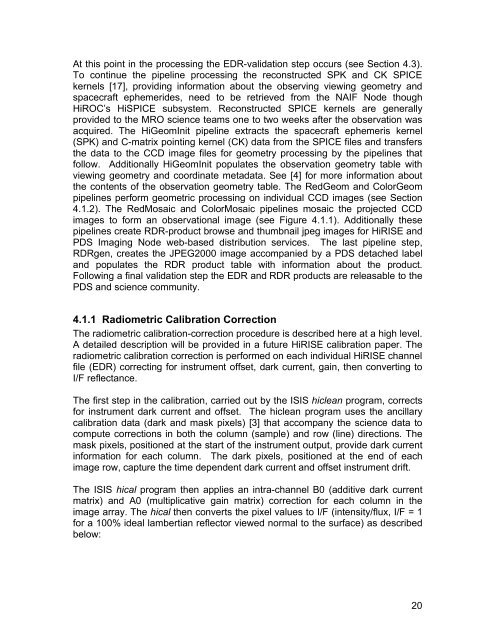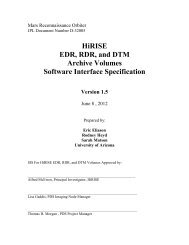Software Interface Specification for HiRISE Reduced Data Record ...
Software Interface Specification for HiRISE Reduced Data Record ...
Software Interface Specification for HiRISE Reduced Data Record ...
You also want an ePaper? Increase the reach of your titles
YUMPU automatically turns print PDFs into web optimized ePapers that Google loves.
At this point in the processing the EDR-validation step occurs (see Section 4.3).<br />
To continue the pipeline processing the reconstructed SPK and CK SPICE<br />
kernels [17], providing in<strong>for</strong>mation about the observing viewing geometry and<br />
spacecraft ephemerides, need to be retrieved from the NAIF Node though<br />
HiROC’s HiSPICE subsystem. Reconstructed SPICE kernels are generally<br />
provided to the MRO science teams one to two weeks after the observation was<br />
acquired. The HiGeomInit pipeline extracts the spacecraft ephemeris kernel<br />
(SPK) and C-matrix pointing kernel (CK) data from the SPICE files and transfers<br />
the data to the CCD image files <strong>for</strong> geometry processing by the pipelines that<br />
follow. Additionally HiGeomInit populates the observation geometry table with<br />
viewing geometry and coordinate metadata. See [4] <strong>for</strong> more in<strong>for</strong>mation about<br />
the contents of the observation geometry table. The RedGeom and ColorGeom<br />
pipelines per<strong>for</strong>m geometric processing on individual CCD images (see Section<br />
4.1.2). The RedMosaic and ColorMosaic pipelines mosaic the projected CCD<br />
images to <strong>for</strong>m an observational image (see Figure 4.1.1). Additionally these<br />
pipelines create RDR-product browse and thumbnail jpeg images <strong>for</strong> <strong>HiRISE</strong> and<br />
PDS Imaging Node web-based distribution services. The last pipeline step,<br />
RDRgen, creates the JPEG2000 image accompanied by a PDS detached label<br />
and populates the RDR product table with in<strong>for</strong>mation about the product.<br />
Following a final validation step the EDR and RDR products are releasable to the<br />
PDS and science community.<br />
4.1.1 Radiometric Calibration Correction<br />
The radiometric calibration-correction procedure is described here at a high level.<br />
A detailed description will be provided in a future <strong>HiRISE</strong> calibration paper. The<br />
radiometric calibration correction is per<strong>for</strong>med on each individual <strong>HiRISE</strong> channel<br />
file (EDR) correcting <strong>for</strong> instrument offset, dark current, gain, then converting to<br />
I/F reflectance.<br />
The first step in the calibration, carried out by the ISIS hiclean program, corrects<br />
<strong>for</strong> instrument dark current and offset. The hiclean program uses the ancillary<br />
calibration data (dark and mask pixels) [3] that accompany the science data to<br />
compute corrections in both the column (sample) and row (line) directions. The<br />
mask pixels, positioned at the start of the instrument output, provide dark current<br />
in<strong>for</strong>mation <strong>for</strong> each column. The dark pixels, positioned at the end of each<br />
image row, capture the time dependent dark current and offset instrument drift.<br />
The ISIS hical program then applies an intra-channel B0 (additive dark current<br />
matrix) and A0 (multiplicative gain matrix) correction <strong>for</strong> each column in the<br />
image array. The hical then converts the pixel values to I/F (intensity/flux, I/F = 1<br />
<strong>for</strong> a 100% ideal lambertian reflector viewed normal to the surface) as described<br />
below:<br />
20




